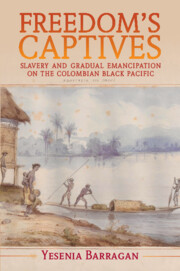Book contents
- Freedom’s Captives
- Afro-Latin America
- Freedom’s Captives
- Copyright page
- Dedication
- Epigraph
- Contents
- Figures
- Tables
- Acknowledgments
- Introduction
- Part I The Social Universe of the Colombian Black Pacific
- 1 Black Freedom and the Aquatic Lowlands
- 2 Slavery and the Urban Pacific Frontier
- Part II The Time of Gradual Emancipation Rule
- Part III Final Abolition and the Afterlife of Gradual Emancipation
- Epilogue
- Bibliography
- Index
1 - Black Freedom and the Aquatic Lowlands
from Part I - The Social Universe of the Colombian Black Pacific
Published online by Cambridge University Press: 18 June 2021
- Freedom’s Captives
- Afro-Latin America
- Freedom’s Captives
- Copyright page
- Dedication
- Epigraph
- Contents
- Figures
- Tables
- Acknowledgments
- Introduction
- Part I The Social Universe of the Colombian Black Pacific
- 1 Black Freedom and the Aquatic Lowlands
- 2 Slavery and the Urban Pacific Frontier
- Part II The Time of Gradual Emancipation Rule
- Part III Final Abolition and the Afterlife of Gradual Emancipation
- Epilogue
- Bibliography
- Index
Summary
Chapter 1 introduces readers to the everyday world of the nineteenth-century Colombian Black Pacific—often neglected in the dominant historiography of colonial and nineteenth-century Colombia—through a narrative-driven historical geography and ethnography of Chocó. Through the journeys of a free black boga (rower) and a female gold miner, among other figures, the first chapter shows the everyday ways in which free blacks and (to some extent) slaves continued to trouble white governmentality during the gradual emancipation years. In many ways, free black and captive lowlanders experienced unparalleled levels of autonomy and independence in this mining frontier by maintaining control over the region’s labyrinth of rivers and gold mines. This chapter likewise reveals how the gold-mining economy’s gendered social structure was transformed after independence and gradual emancipation rule, as enslaved and free black women became the primary laborers in mines increasingly worked by Free Womb captives.
- Type
- Chapter
- Information
- Freedom's CaptivesSlavery and Gradual Emancipation on the Colombian Black Pacific, pp. 39 - 72Publisher: Cambridge University PressPrint publication year: 2021

